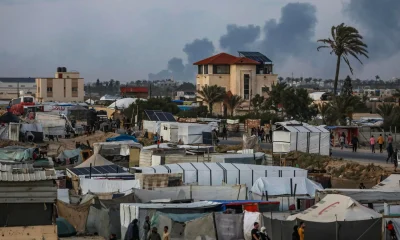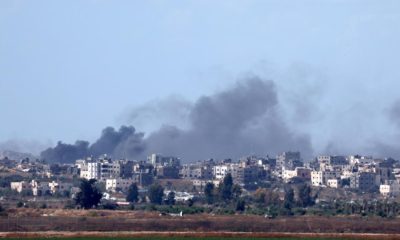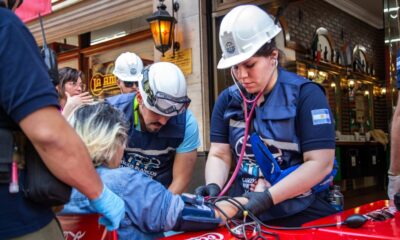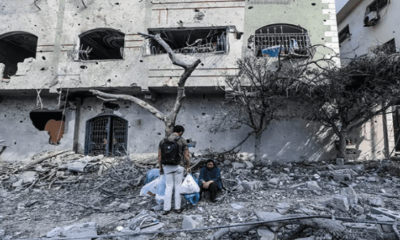International
Negotiations for the truce in Gaza will resume in Doha

Negotiations for the truce in Gaza are scheduled to resume tomorrow, Sunday, in Doha and there will be an Israeli delegation to respond to Hamas’ updated proposal, Egyptian intelligence sources told EFE today.
The source, who asked for anonymity due to the sensitivity of this issue, assured that the new round of talks will take place in Doha and not in Cairo, home of the last consultations, and in them there will be Egyptian, Qatari leaders and a delegation of the Israeli Mossad, without the participation of the Islamist group Hamas.
So far, the Qatari government has not officially confirmed that talks will resume tomorrow in its country.
The Egyptian source close to the negotiations assured that the meeting in Doha will discuss the points of disagreement between the Palestinian and Israeli parties, but it will not be to discuss all the points included in the agreement, since some have been agreed in principle.
He stressed, always according to this source, that the Israeli objections are mainly based on his desire for Hamas to reveal the names of the hostages and the figures of the dead captives.
On the other hand, a Palestinian source in Cairo also aware of the talks pointed out to EFE that the updated draft of Hamas contemplates three phases, instead of two as pointed out the day before.
The first phase provides for an exchange in different stages and a temporary ceasefire that lasts 42 days that later, in the second phase, will become a permanent ceasefire.
In the first phase, the movement conditioned the withdrawal of Israeli forces from Al Rashid Street and from Salah al Din to allow the return of the displaced and the passage of aid to the north of the Gaza Strip, as well as guarantee freedom of movement.
Hamas also offered, according to this source since the Palestinian group has not officially confirmed this information, to release 50 Palestinian prisoners for each living Israeli female soldier, although the informant did not offer more details of the rest of the hostages.
With the start of the second phase, Hamas demands a permanent ceasefire before any exchange of soldiers.
Finally, in the third phase, the proposal includes the implementation of a comprehensive reconstruction of the Gaza Strip and the end of the siege.
The mediators will try to press for both parties to reach a ceasefire, which was expected to be achieved before the Muslim holy month of Ramadan, which began on March 11.
At least 80 civilians, mostly women and children, were killed by Israeli airstrikes in the last hours in Gaza, medical and local sources told the Palestinian agency Wafa, while the Israeli Army claimed to have killed about thirty Hamas militiamen in the strip.
Waiting for the Gaza Ministry of Health to confirm the total number of fatalities this morning, about 36 people died last night in attacks on two houses in the Nuseirat camp, in the center of the Gaza Strip, sources on the ground told the Palestinian agency.
For its part, the army said it had killed 15 alleged militiamen in Nuseirat “hidden in a sie in Hamas” during an air attack, explains a military statement, which says that the attack was led by the 215º artillery regiment “based on intelligence information.”
The same regiment, the army says, conducted a second airstrike “killing a commander of a squadron of snipers from Hamas” and another militiaman.
The rest of the civilian deaths, mostly women and children, perished in the bombing of a seven-storey residential building “that housed displaced people,” according to Wafa, near the Al Shifa hospital, in Gaza City, and in another air attack on a house on Al Jalaa Street in the same city.
In addition, five other civilians died and dozens more were injured in an airstrike against a house in the Al Tuffah neighborhood, and a similar bombing caused an undetermined number of deaths and injuries in the Al Nasr neighborhood, both in Gaza City.
In turn, Wafa reported “intense air strikes” on the city of Beit Hanoun, in the north of the Strip, with bombings that also took place against an inhabited house in Rafah, south of the enclave and where more than 1.4 million displaced people take refuge.
In the center of Gaza, Israeli soldiers of the Nahal Brigade, according to the statement, killed “about 10 armed men” on the last day; and in Jan Yunis fighter planes destroyed “a weapons depot” and attacked alleged militiamen.
After more than five months of war, 85% of the Gaza population has been displaced, and 60% of the infrastructure of the Strip, according to UN estimates, is damaged or destroyed, with malnourished babies and little medical assistance due to Israeli attacks.
A Palestinian armed with a rifle was killed this Saturday by Israeli soldiers shot in a cemetery near a Jewish settlement, within the occupied Palestinian city of Hebron, according to a military statement and a video of the event.
An attacker “opened fire on a Jewish community (colony) in the city of Hebron. The terrorist has been neutralized,” said the army, which reported that soldiers comb the area in search of other possible suspects.
The total number of fatalities increased in recent hours to 31,553 and 73,546 injured since the start of the war in the Gaza Strip on October 7, reported the Ministry of Health controlled by Hamas, after a day of intense attacks in the central area of the enclave.
The Egyptian Foreign Ministry insisted on Saturday that Israel must open all the remaining steps that are not yet operational to introduce aid to the Gaza Strip and prevent the humanitarian situation from worsening.
“Egypt continues to do everything possible to improve the access of urgent aid to Gaza through the Rafah border crossing and through aerial launches,” Foreign Affairs spokesman Ahmed Abu Zeid said in a statement.
And he asked Israel to “remove the obstacles and restrictions it imposes on the entry of aid through land border crossings, and to put the remaining steps into operation so that more aid is entered and thus prevent the humanitarian situation in Gaza from worsening.”
Central America
Senator Van Hollen Meets with Deported MS-13 Member in El Salvador; Trump and Bukele React

U.S. Democratic Senator Chris Van Hollen, representing the state of Maryland, held a meeting in El Salvador with deported MS-13 gang member Kilmar Ábrego García, a member of the criminal group classified by the U.S. government as a terrorist organization.
“Kilmar Ábrego García, miraculously resurrected from the ‘extermination camps’ and ‘torture chambers,’ now sipping margaritas with Senator Van Hollen in the tropical paradise of El Salvador!” wrote President Nayib Bukeleon X (formerly Twitter), sharing photos of Van Hollen, Ábrego García, and a lawyer sitting together at a Salvadoran hotel.
The deported gang member is seen wearing a plaid shirt and a flat-brimmed cap, seated at a table with glasses and coffee cups. The senator also shared images of the meeting on his own social media accounts.
Bukele reaffirmed that Ábrego will remain in El Salvador and will not be returned to the United States.
“Now that his health has been confirmed, he has earned the honor of remaining under the custody of El Salvador,” Bukele added.
Former U.S. President Donald Trump criticized the senator’s meeting with Ábrego on Truth Social, calling Van Hollen “a fool” for advocating for Ábrego’s return to the U.S.
International
Pope Francis Appears for Easter Blessing, Calls for Peace and Religious Freedom

Pope Francis, still recovering from pneumonia, appeared on the balcony of St. Peter’s Basilica in the Vatican on Easter Sunday and, with a faint voice, wished a “Happy Easter” to the thousands of faithful gathered to celebrate the Resurrection of Christ.
A month after being discharged from a lengthy hospital stay, the presence of the 88-year-old pontiff had remained uncertain, with the Vatican not confirming his attendance ahead of time.
Eventually, the pope made a brief appearance in a wheelchair shortly after 12:00 p.m. (10:00 GMT) to deliver his traditional “Urbi et Orbi” blessing (“to the city and to the world”).
Although no longer wearing an oxygen cannula, the Argentine Jesuit relied on a close aide to read his Easter message, which touched on major global conflicts.
Francis condemned the “dramatic and unworthy humanitarian crisis” in Gaza and called for a ceasefire, while also expressing concern over the “growing climate of antisemitism spreading across the globe.”
He further emphasized the importance of religious freedom and freedom of thought, stating that without mutual respect, “peace is not possible.”
International
Thousands rally nationwide against Trump’s threat to U.S. democracy

Thousands of protesters gathered on Saturday (April 19, 2025) in major cities like New York and Washington, as well as in small communities across the United States, in a second wave of demonstrations against President Donald Trump. The crowds denounced what they view as growing threats to the country’s democratic ideals.
In New York City, demonstrators of all ages rallied in front of the Public Library near Trump Tower, holding signs accusing the president of undermining democratic institutions and judicial independence.
Many protesters also criticized Trump’s hardline immigration policies, including mass deportations and raids targeting undocumented migrants.
“Democracy is in grave danger,” said Kathy Valyi, 73, the daughter of Holocaust survivors. She told AFP that the stories her parents shared about Adolf Hitler’s rise to power in 1930s Germany “are happening here now.”
In Washington, demonstrators voiced concern over what they see as Trump’s disregard for long-standing constitutional norms, such as the right to due process.
-

 International4 days ago
International4 days agoArsenal stun Real Madrid at the Bernabéu to reach Champions League semifinals
-

 Central America3 days ago
Central America3 days agoNicaraguan Exiles to Mark 7th Anniversary of 2018 Protests with Global Commemorations
-

 International3 days ago
International3 days agoDominican ‘False Hero’ Arrested for Faking Role in Nightclub Collapse That Killed 231
-
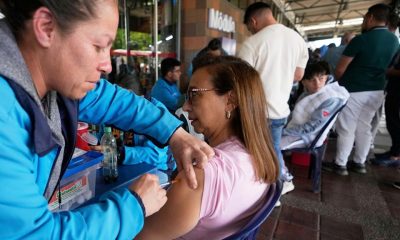
 International4 days ago
International4 days agoBogotá residents line up for yellow fever vaccine amid national alert
-

 International2 days ago
International2 days agoACLU seeks emergency court order to stop venezuelan deportations under Wartime Law
-

 International4 days ago
International4 days agoDeSantis’ immigration crackdown sparks alarm in Venezuelan Communities in Doral
-

 Central America2 days ago
Central America2 days agoUN complaint filed against Costa Rica over detention of migrant children
-

 International4 days ago
International4 days agoMexico refuses to restore ties with Ecuador while Noboa remains in office
-

 International18 hours ago
International18 hours agoThousands rally nationwide against Trump’s threat to U.S. democracy
-

 International12 mins ago
International12 mins agoPope Francis Appears for Easter Blessing, Calls for Peace and Religious Freedom
-

 Central America11 mins ago
Central America11 mins agoSenator Van Hollen Meets with Deported MS-13 Member in El Salvador; Trump and Bukele React
























